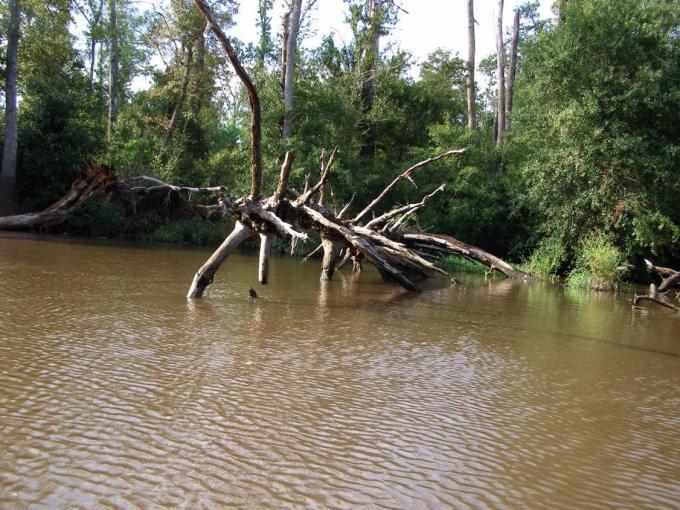Think Small for Fall
Little Secrets. Autumn is traditionally a time for hunting, but it can be a costly mistake to rack your fishing tackle just because squirrels and doves are in season and bow hunters are deer scouting. The action can be too rewarding to ignore!
If you're trying to sandwich in hunting, fishing and scouting, this is the perfect time of year to think about close-to-home angling adventures, maybe to one of Kentucky's smaller public impoundments. Chances are there's one near you.
If you haven't hit one of these small waters, it's a fine time to enjoy their variety, convenience and relatively low fishing pressure. The onset of cooler weather usually means less competition for a spot on the water. Pleasure boating is quickly winding down. Fall is also a beautiful time to take in the brilliant colors around these lakes.
Most of the state's lake fisheries are based on a foundation of largemouth bass, bluegill and channel catfish, but actually few lakes stop there. Most have a wide range of species so that you never know exactly what's going to grab the bait next.
KDFWR-owned lakes are spread all across Kentucky's landscape, but anglers in the eastern half of the state have an edge on this close-to-home fishing. Let's highlight just a few spots regionally, to give you a taste of what to expect. Moving from the Mississippi River toward the Virginia frontier, here are some good bets for fall fishing.
Western Kentucky -- Lake Beshear
(Editors Note: This article is outdated. It was written in the 1990's currently you can not rent a boat or buy tackle at Lake Beshear. I am also being given feedback that the fishing is not as good as indicated as well./ 8-13-2004)
Lake Beshear is in the Pennyrile Forest about four miles south of Dawson Springs and lies in Christian and Caldwell counties. It's been open for fishing for 30 years and you'll find launch ramps, boats, motors and bait at waterside. You can camp there and it isn't a bad place to combine fall fishing and squirrel hunting for a weekend outing.
The lake covers 760 acres. It's not especially deep with a maximum depth of 35 feet and a mean depth of 10 feet. In September, you probably won't find many fish be low about 15-20 feet, even in the deepest holes; below that the oxygen runs out.
Beshear is coming on strong, says Bill McLemore, western district fisheries biologist, after being a kind of so-so fishery for years. "We had a lot of four-inch bluegill, small crappie and skinny, emaciated bass a dozen years ago," says McLemore. At the time McLemore and his crew introduced scads of shad, both threadfin and gizzard. With the new forage source, "the black bass population went wild. Super nice fish, with good weight-to-length ratios; they're comparable to Lake Barkley fish."
There was another result of the shad importation -- great crappie fishing.
"We have good reports of crappie in excess of 13 inches," says the biologist. But don't expect great bluegill fishing at Beshear; it's tough to manage a lake for good populations and good size bass, crappie AND bluegill.
Beshear has livened up so much that McLemore began a creel survey this summer for the first time in years, although the results were not available at this writing.
Statewide size and creel limits apply and no special fishing secrets are required to take good bass and crappie -- all the standard fall baits and techniques seem to work here.
Central Kentucky
Pete Pfeiffer, director of the KDFWR's Division of Fisheries, usually does his fishing in the central and eastern areas of the state and suggests a couple of his fall favorites in each region
Guist Creek Lake
"Guist Creek Lake has good (largemouth) bass fishing and we've fairly recently introduced hybrid striped bass in this lake," says Pfeiffer. Then he adds, "So far, we haven't heard much from them (the stripers.) But we should this fall."
You don't have to wait for the stripes to create enjoyment from this lake. In addition to the plentiful largemouths, the angler can anticipate hanging into redear, green and longear sunfishes, bluegill, black and white crappie, buffalo, white and spotted suckers, black bullheads and channel catfish. (If you do get into a mess of stripes, remember that there is a special regulation covering hybrid striped bass, white bass, and yellow bass at this lake -- a 15 inch size limit and a five-fish daily and possession limit, singly or combined.)
Guist Creek Lake located about five miles east of Shelbyville off US 60, was built in 1961 and opened for fishing two years later. The 31 7-acre lake has a maximum depth of 47 feet and an average depth of 15 feet. A privately owned dock can provide boats, motors, bait and food, notes Pfeiffer, and a fee is charged for launching. Guist Creek Lake has lots of promising embayments, nooks and crannies. While it covers just over 300 acres, the lake has more than 27 miles of shoreline.
Largemouth bass and bluegill anglers should try the area from the surface to four or five feet if they're fishing early or late or at night. The KDFWR profile of the lake shows that during early autumn the best fishing is from the surface to 15 feet. Below 15 feet, there is little or no oxygen.
Elmer Davis Lake
"Elmer Davis Lake is a top bluegill lake," says Pfeiffer, "and we did a shad eradication this spring to make sure that it continues to be good."
Shad usually serve as forage fish for bass and crappie but shad have to eat, too. They compete with bluegill and other sunfishes for some of the same food sources. An overabundance of the minnows can lead to a decline in bluegill and other panfish.
"We just hope that nobody will reintroduce shad," says Pfeiffer. There is now a regulation banning the use of the bait fish in Elmer Davis (and some other smaller lakes).
Fly fishermen can expect plenty of action on poppers and wet flies in the shallows early and late. Small spinners and other mini-baits on ultralight tackle will also keep you busy, as will standard live baits such as worms and crickets.
The l 50-acre lake was opened for fishing 33 years ago. In addition to trophy bluegill you can expect to run into a variety of other sunfishes plus bass, crappie, channel cats and black bullheads.
There is a slot limit on Elmer Davis for both largemouth and smallmouth bass Fish shorter than 12 inches or longer than 16 inches may be kept, but those between 12 and 16 inches must be returned to the water.
In September there is a shortage of oxygen from about 15 feet clown, so whatever baits or lures you're depending on should be fished between the surface and 15 feet. This is a long, narrow, steep steep-sided lake, dropping quickly to depths of nearly 60 feet with an average depth of 21 feet.
Elmer Davis Lake is located in Owen County just outside Owenton off Highway 22. The lake features a paved launch ramp and has a dock providing boats and motors.
Eastern Kentucky
Greenbo Lake "The feature attraction at Greenbo Lake is rainbow trout," says Pfeiffer, "but there's a good variety of other fish, too. Until a few years ago Greenbo boasted the state record for largemouth bass."
What Pfeiffer calls a "good variety of other fish" at Greenbo also includes smallmouth bass, crappie, channel catfish, bluegill and longear sunfish. He says the bluegill fishery is not quite as good as it once was.
This lake, located in Greenbo Lake State Park, 17 miles west of oat Ashland is not only a top fishing spot but also a great place for a family weekend outing. The facility has a boat dock, launch ramp, restaurant, swimming area and camp sites. All these are great for kids moms and dads and a perfect way to spend a September weekend observing National Hunting & Fishing Day (September 24. 1994).
Greenbo Lake covers some 180 acres with a maximum depth of 55 feet and an average depth of 26 feet. It's regularly stocked with rainbows early in the year. The stockers are usually nine-inchers, but rainbows caught now often average in excess of 13 inches and weigh more than a pound. Trout weighing several pounds have been taken here.
Through September, depending on water temperature, many fishermen concentrate on the hours between sunset and midnight and try to locate the depth at which the water temperature is about 60 degrees. At this season, there isn't much oxygen below 15 or 20 feet so there aren't many fish there either. Under these water conditions, both here and elsewhere, you can usually find fish in a narrow band lying between the too-warm water near the surface and the oxygen-poor layer toward the bottom. This zone of just-right water marks the top part of the thermocline. At Greenbo, keep looking for the 60-degree spot. When you find it, stand by it.
Favorite baits in the fall include the tried and true -- canned corn, cheese, night crawlers and a wide range of commercially prepared "trout bait." Standard artificials including flies and smaller spinners and jigs will also account for their share of rainbows and other species as well.
Pan Bowl Lake
Pan Bowl is one of the more unusual impoundments owned by the state fish and wildlife agency; it was once part of the channel of the Kentucky River's North Fork. An oxbow lake was formed when Highway 15 cut across the open end of a river loop and two highway-fill dams blocked the channel at both ends. Now, Pan Bowl is a 98-acre largemouth honey hole, says Pfeiffer, with lots of bass and many of braggin' size.
The lake is located in Breathitt County just north of Jackson. Highway 15 will take you to either end of it. There is a launch ramp for your boat.
The old river bed is relatively shallow with a maximum depth of 20 feet and an average of about 13 feet. Starting in September, look for bass below five feet in the daytime, shallower early and late and at night. There is likely to be an oxygen shortage ranging three or four feet up from the bottom. Into October, bass will spend progressively more time closer to the surface.
In addition to the largemouth action, you may add bluegill and redear sunfish, crappie and channel cats to the stringer, says Pfeiffer.
Other anglers and experts might lean toward other selections from the more than 40 public access lakes we have at our disposal. There are indeed many quality waters from which to choose. A lot depends on where you live, how far you want to drive and what you're looking for. Most fishermen familiar with the public lakes we agree that all are capable of providing an exciting day's fishing with plenty of surprises. Get out this fall and try one of the commonwealth's smaller lakes. They're some of our best kept secrets for fall fishing fun.
Kentucky's public access lakes are described in "A Guide to Public Fishing Lakes in Kentucky," a KDFWR publication. The 100-page booklet is co-authored by Pfeiffer and Bonny Laflin, southwestern district fisheries biologist. The booklet and a copy of current fishing regulations are available free from the Kentucky Department of Fish and Wildlife Resources, #1 Game Farm Rd., Frankfort, KY 40601; phone (502) 564-4336.
Home Page as it was Dec 27, 1996
Old Time Fishing


